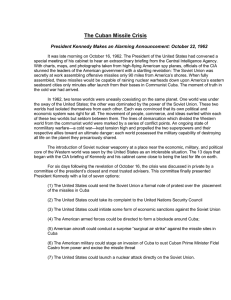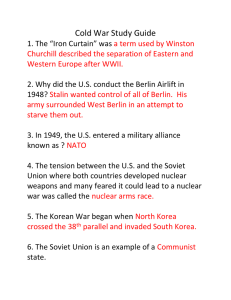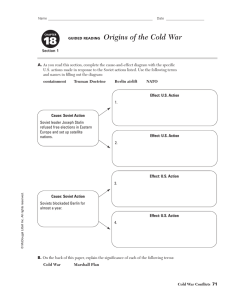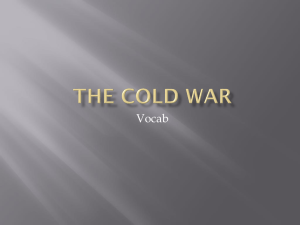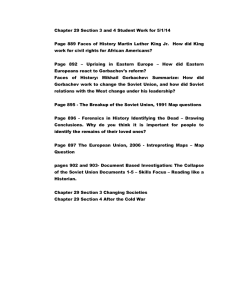US Spring EOC Review Test
advertisement
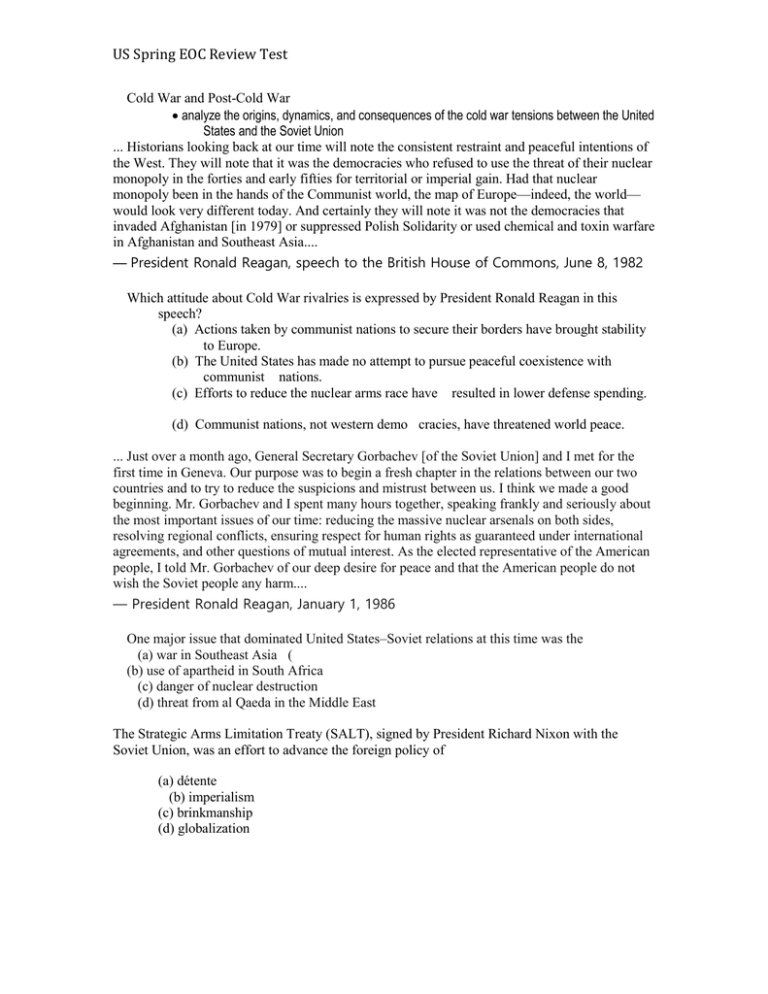
US Spring EOC Review Test Cold War and Post-Cold War analyze the origins, dynamics, and consequences of the cold war tensions between the United States and the Soviet Union ... Historians looking back at our time will note the consistent restraint and peaceful intentions of the West. They will note that it was the democracies who refused to use the threat of their nuclear monopoly in the forties and early fifties for territorial or imperial gain. Had that nuclear monopoly been in the hands of the Communist world, the map of Europe—indeed, the world— would look very different today. And certainly they will note it was not the democracies that invaded Afghanistan [in 1979] or suppressed Polish Solidarity or used chemical and toxin warfare in Afghanistan and Southeast Asia.... — President Ronald Reagan, speech to the British House of Commons, June 8, 1982 Which attitude about Cold War rivalries is expressed by President Ronald Reagan in this speech? (a) Actions taken by communist nations to secure their borders have brought stability to Europe. (b) The United States has made no attempt to pursue peaceful coexistence with communist nations. (c) Efforts to reduce the nuclear arms race have resulted in lower defense spending. (d) Communist nations, not western demo cracies, have threatened world peace. ... Just over a month ago, General Secretary Gorbachev [of the Soviet Union] and I met for the first time in Geneva. Our purpose was to begin a fresh chapter in the relations between our two countries and to try to reduce the suspicions and mistrust between us. I think we made a good beginning. Mr. Gorbachev and I spent many hours together, speaking frankly and seriously about the most important issues of our time: reducing the massive nuclear arsenals on both sides, resolving regional conflicts, ensuring respect for human rights as guaranteed under international agreements, and other questions of mutual interest. As the elected representative of the American people, I told Mr. Gorbachev of our deep desire for peace and that the American people do not wish the Soviet people any harm.... — President Ronald Reagan, January 1, 1986 One major issue that dominated United States–Soviet relations at this time was the (a) war in Southeast Asia ( (b) use of apartheid in South Africa (c) danger of nuclear destruction (d) threat from al Qaeda in the Middle East The Strategic Arms Limitation Treaty (SALT), signed by President Richard Nixon with the Soviet Union, was an effort to advance the foreign policy of (a) détente (b) imperialism (c) brinkmanship (d) globalization US Spring EOC Review Test What is the main idea and indication illustrated in this photo (a) (b) (c) (d) Americans enjoyed leisure living Only government staff were secure should a nuclear attack happen Americans were eager to help create nuclear weapons There was a fear in the US during the early years of the Cold War Which action has come to symbolize the end of the Cold War? (e) (a) establishing the Peace Corps (f) (b) achieving a truce in the Korean War relations with China (c) tearing down the Berlin Wall (d) improving United States assess the new role of the United States as a world leader (Students’ knowledge should include, for example: the Marshall Plan and NATO.) The creation of the North Atlantic Treaty Organization (NATO) illustrates a commitment to the concept of (a) colonialism (b) mutual defense (c) isolationism (d) human rights The principal goal of the United Nations has been to (a) develop military alliances around the world (b) encourage expansion of international trade (c) promote peaceful solutions to world problems (d) regulate the use of atomic energy US Spring EOC Review Test Source: Dorman Smith, Phoenix Gazette, 1949 (adapted) Which statement most accurately expresses the main idea of the cartoon? (a) American taxpayers hope the Marshall Plan will quickly stabilize Europe’s economy. (b) The Marshall Plan will limit Europe’s economic recovery. (c) Europe will not take advantage of the Marshall Plan. (d) The Marshall Plan will bankrupt the American taxpayer. “... There is one sign the Soviets can make that would be unmistakable, that would advance dramatically the cause of freedom and peace. General Secretary Gorbachev, if you seek peace, if you seek prosperity for the Soviet Union and Eastern Europe, if you seek liberalization: Come here to this gate! Mr. Gorbachev, open this gate! Mr. Gorbachev, tear down this wall!...” — President Ronald Reagan, June 12, 1987 President Reagan was calling for the end of the (a) nuclear arms race (b) Soviet invasion of Afghanistan (c) division of Berlin, Germany (d) Warsaw Pact ... We dare not forget today that we are the heirs of that first revolution. Let the word go forth from this time and place, to friend and foe alike, that the torch has been passed to a new generation of Americans—born in this century, tempered by war, disciplined by a hard and bitter peace, proud of our ancient heritage—and unwilling to witness or permit the slow undoing of those human rights to which this nation has always been committed, and to which we are committed today at home and around the world.... To those people in the huts and villages of half the globe struggling to break the bonds of mass misery, we pledge our best efforts to help them help themselves, for whatever period is required—not because the communists may be doing it, not because we seek their votes, but because it is right. If a free society cannot help the many who are poor, it cannot save the few who are rich.... US Spring EOC Review Test — President John F. Kennedy, Inaugural Address, January 20, 1961 According to this quotation, President Kennedy wanted to (a) assert United States leadership in world affairs (b) follow a policy of neutrality (c) adopt appeasement as a foreign policy (d) abandon the policy of containment Which foreign policy action by President Kennedy was intended to relieve the human suffering described in this quotation? (a) creating the Peace Corps (b) authorizing a naval blockade of Cuba (c) meeting with Soviet Premier Nikita Khrushchev in Vienna (d) negotiating the Nuclear Test Ban Treaty analyze the implementation of the foreign policy of containment, including the Truman Doctrine In the years immediately following World War II, United States foreign policy was primarily focused on (a) securing peace in the Middle East (b) containing the spread of communism (c) sending volunteers to developing countries (d) maintaining neutrality in world conflicts summarize the causes and effects of the Red Scare (Students’ knowledge should include, for example: McCarthyism, House Un-American Activities Committee, nuclear weapons, the Arms Race.) “Attorney General Palmer Deports 249 Foreigners” (1919) “Nixon Accuses Alger Hiss of Espionage” (1948) “Rosenbergs Executed for Treason” (1953) Each of these headlines demonstrates that during the 20th century (a) the rights of the accused were expanded (b) membership rose dramatically in groups considered to be subversive (c) censorship was a primary policy of the govern- ment (d) fear of communist activities prompted govern- ment actions Between 1946 and 1954, the House Committee on Un-American Activities and Senator Joseph McCarthy attracted public attention by investigating (a) allegations of communist influences in government (b) civil rights violations against African Americans (c) corruption by companies in the defense industry (d) war crimes of German and Japanese officials McCarthyism in the 1950s is most closely associated with US Spring EOC Review Test (a) (b) (c) (d) claims that communists had infiltrated the federal government efforts to prevent pro-communist govern- ments in Latin America formation of the Warsaw Pact passage of the Interstate Highway Act draw conclusions from external confrontations with communism (Students’ knowledge should include, for example: the Berlin blockade, the Berlin Wall, Bay of Pigs, the Cuban Missile Crisis, Korea, Vietnam War.); Which action has come to symbolize the end of the Cold War? (a) establishing the Peace Corps (b) achieving a truce in the Korean War (c) tearing down the Berlin Wall (d) improving United States relations with China Which newspaper headline would have appeared after the breakup of the Soviet Union? (a) “Russian Troops Invade Afghanistan” (b) “Poland and Hungary Join NATO” (c) “President Carter Announces Camp David Agreement” (d) “President Nicaragua” The Cuban missile crisis was effectively ended when the (a) Soviet Union agreed to withdraw weapons from Cuba (b) Bay of Pigs invasion removed Fidel Castro from power (c) Cuban authorities signed new trade agree- ments with the United States (d) United States announced the formation of the Alliance for Progress The Berlin airlift was used during the Cold War to (a) rescue people fleeing West Germany (b) prevent a communist takeover of Greece and Turkey (c) overcome a blockade created by the Soviet Union (d) support peacekeeping efforts by the North Atlantic Treaty Organization (NATO) The creation of the North Atlantic Treaty Organization (NATO) illustrates a commitment to the concept of (a) colonialism (b) mutual defense (c) isolationism (d) human rights The major reason the United States became involved in the Korean War was the (a) threat of communism spreading throughout Asia (b) need to prevent war between China and the Soviet Union (c) demand by the United States for Korean natural resources (d) desire to limit Japanese expansion US Spring EOC Review Test Which of the following BEST explains the primary reason why the placement of Soviet missiles in Cuba created a problem for the United States was because (a) the presence of missiles in Cuba would lead to Cuba gaining an upper hand in the Space Race (b) the geographic location of Cuba meant that a Soviet attack was physically possible (c) the presence of missiles in Cuba would prevent the US from attacking the Soviet Union (d) the presence of missiles in Cuba would prevent the US from attacking Cuba Source: Thomas A. Bailey, A Diplomatic History of the American People, Prentice Hall, 1980 Which conclusion is supported by the information provided on this map? (a) The United Nations could have won the war by sending its troops across the Yalu River. (b) South Korea was never in danger of being defeated by North Korea. (c) The war did little to alter the territorial division of Korea. (d) China refused to aid North Korea. The perceived threat of communist influence in the United States during the 1950s prompted Congress to (a) ban foreign students (b) repeal loyalty oaths (c) deport citizens who were communists (d) investigate suspected communist sympathizers The Gulf of Tonkin Resolution (1964) provided congressional support for (a) withdrawing from the United Nations (b) expanding the Alliance for Progress US Spring EOC Review Test (c) escalating military action in Vietnam (d) reestablishing trade with Cuba analyze the impact of Sputnik and the Space Race Which of these events related to space exploration occurred first? (a) Neil Armstrong walking on the Moon (b) development of the space shuttle (c) John Glenn orbiting Earth (d) launching of Sputnik KENNEDY WARNED OF SPACE SETBACK Task Force Says Soviet Will Probably Orbit Man First — Asks Reorganization By W. H. Lawrence Special to The New York Times. PALM BEACH, Fla., Jan. 11 — A task force on space programs warned President-elect John F. Kennedy today that the United States was lagging behind the Soviet Union in ballistic missiles and outer- space exploration. The group said that the lag in developing powerful booster rockets made it “very unlikely that we shall be first in placing a man into orbit around the earth.” Source: New York Times, January 12, 1961 (adapted) President Kennedy responded to warnings like this by (a) promising to explore Mars and other nearby planets (b) asking Congress to fund the Hubble telescope (c) pledging to put a man on the Moon within a decade (d) joining the Soviet Union in building a space station Which event marked the beginning of the space race with the Soviet Union? (a) U-2 spy plane incident (b) launch of Sputnik (c) Berlin airlift (d) creation of the space shuttle program analyze the reasons for the political protests of the Vietnam War BUT HOW TO LET GO — GRACEFULLY US Spring EOC Review Test Source: Vaughn Shoemaker, Chicago American, 1965 (adapted) What is the principal message of this cartoon? (a) The United States is afraid of a united Vietnam. (b) Other nations in Southeast Asia might fall to communism. (c) President Lyndon B. Johnson is finding it difficult to exit Vietnam. (d) President Lyndon B. Johnson is worried about a communist attack on the United States. evaluate the role of technology in the Information Age
